Updated on 4 June 2023
From MiG-1 to MiG-3
The SKF resolution of October 2, 1940, required the increase of
the range of new fighters to 1,000 km, at the 90% of maximum speed, measured
with fuel contained in internal tanks only. So Zavod 1 was ordered to develop
a new version of the I-200 that met this request.
To increase range and to remedy to some other defects, some modifies
were made to the original series I-200:
-
to increase fuel capacity, a new tank with a capacity of 250 l was installed
under the fuselage;
-
to find place for the tank, the water cooler was moved aft and replaced
with a larger one, now an OP-310;
-
both structures were enclosed in a long cowling called karakatitsa
(cuttlefish);
-
to balance the new tank, the engine mounts were leghtened 100 mm, bringing
the total lenght of the new version to 8250 mm instead than 8150;
-
the predisposition for external auxiliary tanks was deleted to save weight;
-
the dihedral was increased by 1°, passing from 6° to 7° to
increase lateral stability;
-
the main undercarriages were modified, with new wheels of the size
650x200 mm to support the increased weight of the machine;
-
their doors were modified, and the small wheels shields, looking as those
of I-16, were replaced by doors hinged under the fuselage;
-
the tail wheel was rubberized, of increased diameter, and this required
to open a slot in its doors to let it protrude when retracted;
-
the tanks were self-sealing.
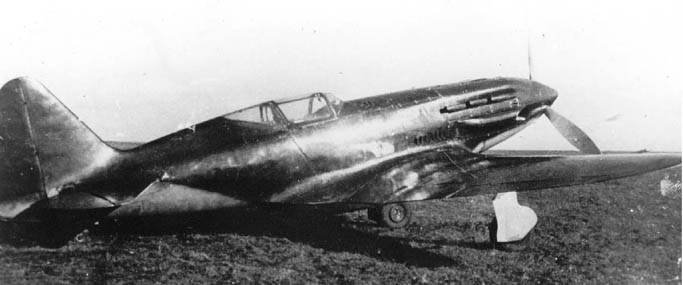 |
The prototype of the new version was the I-200 no.04, that was ready
for the factory tests on October 21.
It was still 8.15 m long, as earlier prototypes; the increase in length
started with series MiG-3s..
It flew on October 29, 1940, flown by A.N. Ekatov.
At the end of November the aircraft was sent to the South to escape
bad winter weather for the purpose to conduct joint testing with NII-VVS.
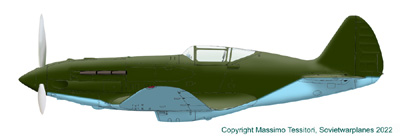
|
The older version was officially named MiG-1, and the new version MiG-3,
according to order NKAP no.704 of December 9; such names were already unofficially
in use in the bureau.
The MiG-3, was put into production on 20 December 1940, starting with
machine number 2101 (101st series aircraft); the modification created
some chaos in the production line, that was already functioning at full
rate.
It was decided to build 3500 MiG-3 in Zavod 1 during the year 1941,
and to start the production in Kiev, where it was projected to build 100
further MiG-3s during 1941. This latest production line was never started.
After 100 MiG-1 built up to mid December, 1940, Zavod 1 Moscow-Vnukovo
produced 20 MiG-3s in late december 1940, and 150 MiG-3s in January 1941.
During February the production increased, and in March it 1941 it reached
a rate of 70 per week; by March 28, 473 MiG-3s were built,
of which 270 were already sent to operative units.
At that time, they considered producing the new version of the fighter
at Zavod No.21 in Gorkiy (now Nizhniy Novgorod) and at Zavod no.43 in Kiev,
but this idea was soon abandoned.
Aviation repair depots in Riga were adapted for the MiG-3 maintenance. |
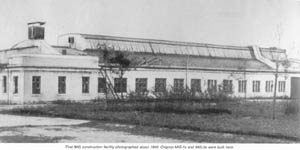 |
This hurry to build new fighters and to re-equip operative units with
them was due to the fear to be surprised unprepared by the incoming war,
but it caused a deterioration in produced aircrafts quality: MiG-3s built
on this period were slower and rougher than prototypes, and prone to many
types of faults. Besides, many of the required improvements were not quickly
introduced into production.
The state tests
The tests on I-200 no.04 were never completed; two series MiG-3s, n.2107
and 2115, were employed for state tests from January 27 to February 26,
1941, flown by the pilots captain A.G. Proshakov and A.G. Kochetklov.
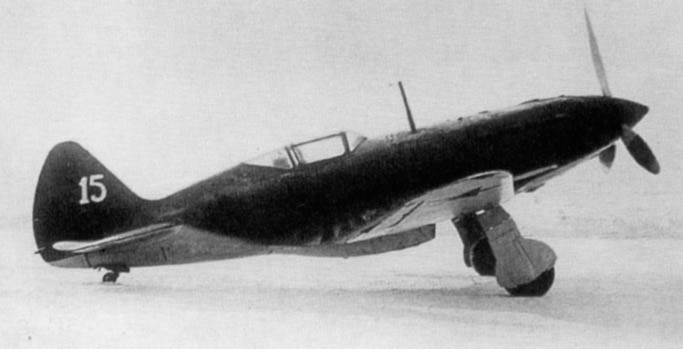
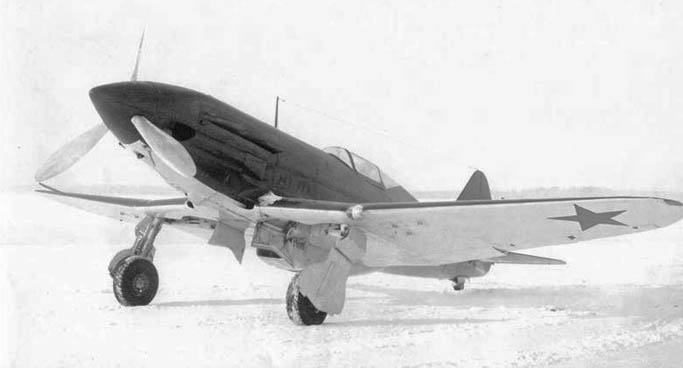
|
These tests were intended to compare with the old MiG-1, to detect defects
, to estimate stability and spinning properties and to determine flight
performances.
As results:
-
the mass of the aircraft was increased from 3100 kg (of the MiG-1) to 3355
kg;
-
the horizontal speed was the same;
-
the rate of climb deteriorated, requiring 1,71 min more to reach 8000 m
altitude;
-
spin characteristics were the same of I-200, in fact the aircraft could
recover from spin after two turns;
-
being unstable and with large load on ailerons, the aircraft rapidly tired
the pilots;
-
the armament worked reliably;
-
the range of the RSI-3 radio was 150 km;
-
it was noted that the VISh-22 propeller was unadequate, because the insufficient
angle of rotation of blades (20°) causes a dangerous augments of engine
rotation rate during dives at angles of 50-60° or more;
-
the pick-up of AM-35a engine was considered inadequate too.
Left: no.2115
|
Flying range controversy
Flying range of the MiG-3 was checked using the route Chvalovsk-Seym-Chkalowsk-Moscow
(Central Airfield), for a total of 710 km, with a speed of 574 km/h (90%
of top speed) at an altitude of 8,000 m, with the engine at 1950 rpm. On
22 February 1941 the MiG-3 n.2115 was refuelled with 463 kg of fuel at
taking off; on landing, there remained 84 kg in its tanks, of which 34
were not usable because of design defects; this led to calculating the
range at 820 km.
MiG-3 n.2107 gave comparable results.
This was obviously less than the 1000 km range required. The tests
were made without the altimetric fuel ratio compensator on, because, according
to the engine manual released by Zavod 21 that built the Mikulin engine,
this could not be used at an altitude of 8,000 m.
The factory technicians, however, disagreed with this limitation. Mikoyan
decided, with the agreement of the engine designer A.Mikulin, that the
altimetric compensator should be used for the tests. On April 4, the chief
designer A.I. Mikoyan and his assistant M.I. Gurevic wrote to the People's
Commissar of the Aircraft Industry, A.I. Shakhurin, that they had calculated
reliably a range of no less than 1000 km, on the basis of a fuel consumption
of 0,38 kg/km, while it reached 0, 48 kg/km during state tests, because
the altimetric compensator was not used during the NII-VVS tests, causing
an increase of fuel consumption.
Tests conducted on April 19 by Zavod 1 on two series aircrafts confirmed
the results of the calculation, giving a flight range of 1180 km.
Tribunals and scapegoats
Overall, the program for the modernization of the fighter line met a
lot of troubles, partly due to excessive hurry. The aircrafts delivered
to the operative units revealed a lot of costructive defects, while the
improvements suggested by the test pilots were not immediately introduced
into production. All these factors worsened the already difficult flight
characteristics of the machine, that caused accidents and a wide opposition
to it by most pilots.
The government feared that the program had to be considered failed.
This meant not only that a lot of resources had been wasted, and that great
hopes were deluded, but that the V-VS fighter line modernization would
be delayed for many months, while the war was obviously incoming.
Some scapegoats were needed.
The most obvious one could have been Mikoyan, but his hypothetical
remotion meant the definitive failure of the MiG-3 program; besides he
was brother of Anastas Mikoyan, Commissar for Foreign Trade.
Someone more expendable was needed.
Partly because of the wrong results of the flying range tests, the
chief of the NII-VVS, Major General A.I. Filin was sent to a military tribunal
(where Artyom Mikoyan himself deposed against him), and then shot. His
great merits didn't save him: he was the first to receive the pilot-engineer
qualification, he took part in flight tests of all the new aircrafts and
knew well all their merits and defects, and was a major expert on the subject
of spinning; also, he established a new flight endurance record of 75 hours
on a Tupolev ANT-25RD, together with M.Gromov and I. Spirin. He was chief
of the NII-VVS for 3 years.
Additionally, many section chiefs of NII-VVS , as A. Voydevodin, P.
Nikitchenko and M.Maksimov were removed from their posts. All of them were
unjustifiably accused of sabotage and hindering the introduction of new
aircrafts.
Even N.N. Polikarpov came under investigation, because the project
X had been his own, and he had delayed its promised start of some months
in 1939. Although he was not persecuted, this investigation contributed,
aside the I-180 failure, to his total loss of influence, and to the move
of him and his team from Moscow to Novosibirsk, where he continued to work
on some excellent projects that had not any productive result.
Chief Designer V.Romodin was investigated too, and, although not persecuted,
he was transferred to Novosibirsk aside Polikarpov.
The upgunned MiG-3s production
The standard armament of the MiG-1 and of early MiG-3s was composed
by one 12,7 mm UBS gun and two 7,62 mm ShKAS guns, all on the nose.
From February 20, 1941, a new version with two further 12,7 mm
BK guns on under-wing pods with 145 rounds each entered production.
The new standard revealed itself unsatisfactory, as the weight increased
of about 150 kg, deteriorating the flight characteristics of the aircraft;
besides, the firing at high g manoeuvres was imprecise due to torsion flexing
of the wings, so the most of the gun pods were removed when the aircrafts
arrived at the units.
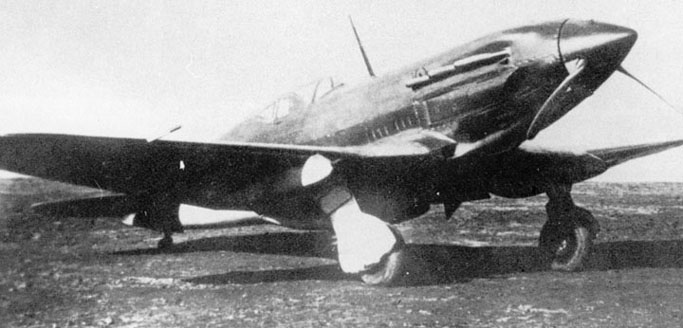 |
821 examples with 5 guns were produced through July 27, 1941, when
the under-wing guns were deleted from production, and the armament returned
to the original standard.
The predisposition for under-wing guns pods (i.e., reptangular panels
for ammo visible under the wings) seems to have remained on following aircrafts
too, and it looks to have been suppressed only towards the end of MiG-3
production. |
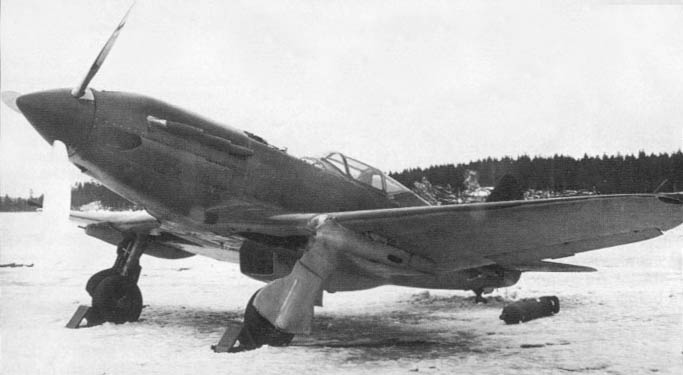 |
On the photos, we see two still unmarked examples with gun pods.
The example above is n. 2109 during tests.
The example below could be the same, or very similar; it lacks
of the nose guns covering panels and of radio mast.
The object on the ground is a compressed air bottle; the central wheels
doors are closed by hand for photographic or maintenance purposes. |
Accidents during tests and introduction into
service
On 12 January,1941, the test pilot V.Kuleshov entered into a spin and,
although he tried to save his aircraft, he crashed and was killed.
Another test pilot, N.Baulin, suggested that new monoplanes should
be piloted differently than biplanes: overcorrection of the control column
during loops caused spins.
Another test pilot, V.Gursky, had to make seven emergency landings
in four days of tests, and in two cases he went close to disaster.
The aircraft was difficult to master even for experienced test pilots,
it created major problems for the typical Soviet pilot of early 1941, whose
training was not advanced.
Many accidents happened during the introduction of the new type.
One of the first units to receive them was 16th IAP of the Moscow Air Defence,
that assigned them to experienced pilots.
On March, the best pilots of 34th IAP visited the Zavod 1 and were
trained to fly MiG-3s; by 1st May, all the pilots of the unit were able
to fly the aircraft for the parade. Three days before, a pilot was killed
in an accident.
On March 13, the oldest test pilot A.N.Ekatov died while testing the
MiG-3 n.2147.
This happened during a test to determinate the rate of climb,
maximum speed and fuel consumption at high altitude.
Investigation showed that the supercharger exploded, damaging the aircraft
and hitting the pilot, who was unconscious at the moment of the impact
with the ground.
The aircraft digged a crater nearly ten feet deep.
This accident revealed the unsufficient safety factor of the supercharger
impeller; it was 26% at the nominal rate of the engine (2050 rpm), but
it reduced to 6% only at the maximum rate of 2350 rpm. Besides, the material
of the impeller (alloy AK-1) was prone to material fatigue. |
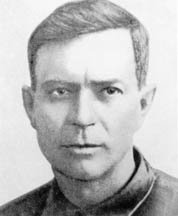 |
Disclaimer
This work collects also a lot of photos and drawings from many
sources, not always identified and mentioned.
If someone has some rights on the images here reproduced, please email to me
and I shall provide to remove or to credit them.
While the historical photos are of public domain (except where otherwise stated),
my color profiles and coloured photos are copyrighted.
If someone is interested in any use of them, please email
me; higher resolution version is available for printing purposes.
If someone has questions, critiques or corrections, or some further images to
show, please email to me.
Massimo Tessitori







